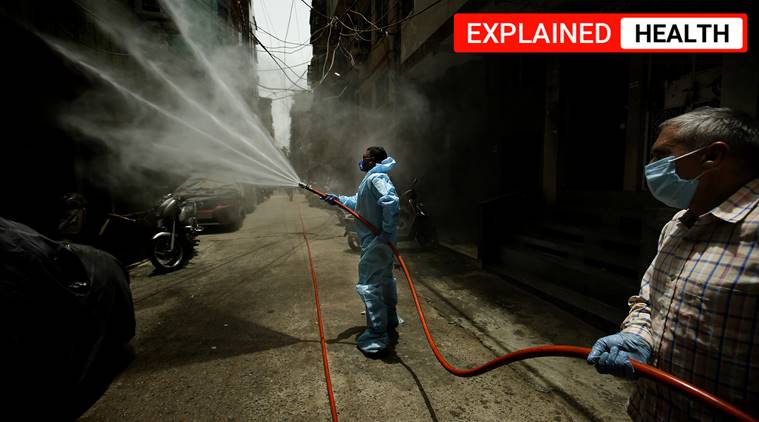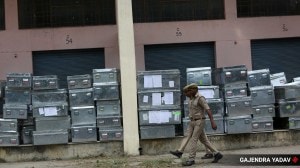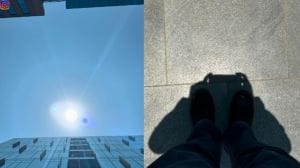- India
- International
Explained: What are containment zones, how are they demarcated?
Demarcation of containment zones serves the same purpose as lockdown and classification of districts, but at a more micro level. A look at how the criteria vary from state to state, city to city.
 A containment zone in New Delhi being sanitised. (Express Photo: Praveen Khanna)
A containment zone in New Delhi being sanitised. (Express Photo: Praveen Khanna)
In the current pandemic, all interventions are primarily geared towards reducing people-to-people contact, and thus breaking the chain of transmission to the extent possible.
That is the objective with which the lockdown was imposed, red, orange and green districts were classified, and containment zones were demarcated. The first two measures, which are operational at the macro level, have all but gone, due to various compulsions. The demarcation of containment zones, which works at a more micro level, is likely to remain as long as the disease is spreading. In fact, experts say this is the only practical isolation strategy available to authorities, and local administrations both in urban and rural areas need to be empowered and equipped to manage this effectively.
What are containment zones?
The lockdown, implemented in five phases, worked at the national level, while the classification of red, orange and green districts operated at the state and inter-district levels. Demarcation of containment zones is done within a town, village, or municipal or panchayat area.
Neighbourhoods, colonies, or housing societies where infected people live are sealed, and access is restricted. Containment zones are where the restrictions on movement and interaction are the most severe. In many cities, the entire demarcated area is barricaded and the entry and exit points closed. Only the very basic supplies and services are allowed inside.
Who defines the containment zones?
It is the district, town or panchayat authorities that decide which areas have to be marked as containment zones, how large they would be, and what kind of restrictions would apply. The rules for the national lockdown, for example, were set by the central government, while the state governments decided what restrictions to impose on districts.

The district administration, municipal corporation or panchayat bodies exercise a great deal of discretion in demarcation of containment zones. The definition and time period vary, and are continuously reviewed and updated.
How are they demarcated?
The parameters used are similar, but the exact criteria applied varies, and usually depends on local conditions. These have also evolved with time, and are under constant review. In general, containment zones are getting smaller with time as the number of cases are increasing — from entire localities, to colonies or neighbourhood, to streets and lanes, to particular buildings, and now just particular floors.
As of now, in Delhi, a containment zone is declared if three or more infections are detected. In Gurgaon, if five positive cases emerge within a 1-km radius, that area is desginated a containment zone. In Noida, an area within a radius of 250 m, or one floor of a building, is declared a containment zone, even if one person is found positive.
While some cities denotify areas after 28 days if no fresh case emerges from the containment zone, this period is seven or 14 days in some other cities. The perimeter of the containment zone is also different in different cities.
📣 Express Explained is now on Telegram. Click here to join our channel (@ieexplained) and stay updated with the latest
So, what are the criteria being followed by various states and cities?
Mumbai: One of the first areas designated was entire Worli Koliwada. But as cases rose, the size of containment zones had to be reduced. Now, either buildings or floors are declared containment zones. Mumbai now has two categories, containment zones and sealed buildings. As of now, there are 755 containment zones and 6,174 sealed buildings.
Ahmedabad: Initially entire wards were declared containment zones, if 100 or more cases were detected there. The city has 48 wards. Now, either one building or five houses in a row are declared containment areas. An official said the authorities usually go by the “concentration of cases” and decide on a case-to-case basis. The radius usually used is 50 to 100 m. The status is reviewed after two weeks.
Lucknow: In a multi-storey building, if one case is found, then the floor is sealed. If there are more cases, the entire building or tower is sealed. In row houses, an area within a radius of 25 m is declared containment zone. The status is reviewed after two weeks.
Kerala: If people in home quarantine test positive, or if someone without a known source of infection tests positive, their residential locality and place of work are declared containment zones. In a town, this area could extend to a street or a colony. In a village, this generally extends up to a ward that usually has a few hundred houses. The status of the containment zone is reviewed after a week.
Karnataka: In apartment complexes, the floor where a positive case lives, and the floors directly above and directly below are declared a containment area. Outside the complex, usually the street is designated a containment area, but often the district administration uses its discretion to define the perimeter. The status is reviewed after two weeks.
Chhattisgarh: One positive case is enough to get an area declared as containment zone, but how big the area would be is left for the local authorities to decide.
West Bengal: In Kolkata, now only the building or apartment complex in which a positive case is detected is designated as containment zone. Depending on the concentration of cases, sometimes adjoining lanes and neighbouring buildings are also included. As of now there are 1,451 containment zones in the city.
Assam: The district administrations usually go by three main criteria – more than 200 cases in any area; the original source of transmission not being traceable; or a doubling rate of cases being less than four days.
Madhya Pradesh: Initially a 1 km radius was declared as containment zone, and another 2 km as buffer zone. The containment used to remain for 21 days. Now, only adjacent houses or buildings are included. Neighbours are tested after six days, and if no one is found infected, the area is denotified.
Punjab: An area with 15 or more positive cases is declared containment zone. Currently, there are only four containment zones in the state – two in Ludhiana and one each in Jalandhar and Sangrur, according to Punjab’s nodal officer for Covid19, Dr Rajesh Bhaskar. But there are 40 micro-containment zones that have between five and 15 positive cases. Another 104 clusters have been defined, with two to four cases each. The boundaries are decided by a local committee constituted by the district administration.
Rajasthan: Additional Chief Secretary Rohit Kumar said the containment zones were initially meant to be areas within 1 km radius of a building or locality with a positive case, with a 3-km radius buffer zone. Now, there is no strict definition, and the guidelines say it should be a “small identifiable geographical area where perimeter control is possible”.
Haryana: If one person is infected, only houses in close proximity, depending on population density, are included in a containment zone. If there are more cases, then the containment area increases. The area in a radius of 3 km is declared a buffer zone. The area is denotified if no fresh case is reported in 28 days.
Goa: Only when a cluster of cases is reported that a locality is it declared a containment zone. Currently, there are 12 containment and micro-containment zones.
More Explained
EXPRESS OPINION
Apr 24: Latest News
- 01
- 02
- 03
- 04
- 05
































